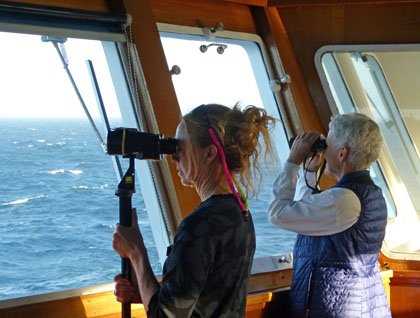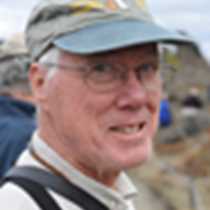Morning on the bridge of the National Geographic Explorer is my favorite time. Arrive early and you find a bright full moon shining off the water in front of us, and then fading as the sun rises in the east behind us. Night turns into day, and we begin to see seabirds coursing over the waves. Clear the whiteboard of yesterday's sightings and begin anew: white-chinned petrels, soft-plumaged petrels, sooty shearwaters, and great shearwaters - all of the group of tube-nosed seabirds, using the energy of the wind to soar gracefully over the waves. Yesterday was a seven-albatross-species day; can we possibly match it? We can only try.
By ones and twos, guests join us on the bridge, still wiping sleep from their eyes, with steaming mugs of coffee in hand. We admire the morning light, debate the sea state, check our location on the chart against the gps reading. Conversation ranges from the sublime (what is the most numerous of the world's seabirds, and how do seabirds sleep?) to the ridiculous (I won't go there.) We are joined by our whale biologist team of Bob Pitman and Lisa Balance - constantly scanning the distance for anything that will indicate the presence of whales or oceanic dolphins: spouts, splashes, aggregations of birds. [Add hourglass dolphin to the list on the board.] They are ever-patient in sharing their experience and knowledge, even as they continue to scan.
The bridge runs like a finely tuned clock, and we are grateful that our ship's officers are willing to share their space, even if we occasionally get in the way. At 6:00, Chief Mate Aaron replaces Ice Master Magnus as the officer of the watch, and the bridge music changes. Promptly at 6:05, AB (Able-bodied Seaman) Roel appears with a plate of morning pastries, fresh from the bakery. His arrival is greeted with satisfied sounds from the increasing bridge contingent. [Add northern giant petrel to the list.] Lisa arrives for her morning wake-up call, gentle as always, and we retreat to breakfast. Another day has begun. Morning on the bridge of the National Geographic Explorer.
By mid-afternoon the Falkland Islands could be made out in the distance. We are grateful that our bridge officers managed to steer a course that avoided the winds and swells of the storm that is passing to the south of us. As we crossed onto the continental shelf, we began to see the spouts of sei whales, blown over by the wind. [Add another species to the list.] The Falklands loom larger. We pull into Long Island Sound for a quiet night at anchor. The sky blazes red at sunset. Later, with clear skies, the Southern Cross can be made out almost directly above us. A day at sea has come to a close, and so to bed to rest for tomorrow's adventures in Stanley, the capital of the Falkland Islands.







